Episode 211
What you’ll learn in this episode:
- What the difference between an artist and a designer is
- The barriers that can make it difficult for solo jewelry artists to enter the retail market, and how Colette overcame them
- What Colette has discovered about her creative process by working with George Brown College psychology students on a research project
- Why it’s important for artists to avoid looking at trends in stores and on social media too frequently
- How a spontaneous haircut sparked Colette’s creativity and paved the way for her future business
About Colette Harmon
Colette Harmon’s one-of-a-kind accessories are a dazzling blend of crystal, mixed metals and semi-precious stones. With an appreciation for meticulous craftsmanship, the metal meshing and intricate beadwork in each of her statement pieces are an audacious departure from mainstream minimalism.
Born in Sisters Village, Guyana, Colette studied fashion design in Toronto before apprenticing as a belt and handbag designer for a leather goods manufacturer. Harmon soon founded her own eponymous label, whose name became synonymous with maximalist glamour.
Harmon’s modern approach to vintage flair has earned her a devoted following of customers, fans and fashion stylists from across North America. Her pieces have been sold in Saks Fifth Avenue and Holt Renfrew Canada, and her work has been featured in Elle Canada, Flare, Martha Stewart Weddings and Nylon. She currently focusses on one-of-a-kind couture creations for select clientele.
Additional Resources:
Photos:
24kt gold plated chain and crystal necklace
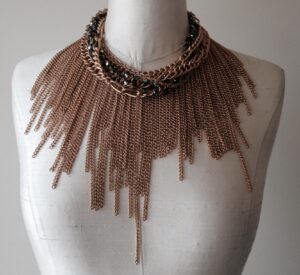
24kt gold plated, multi-strand collar, bib necklace – mix of crystals, semi-precious stones, glass beads, filigree and metal castings
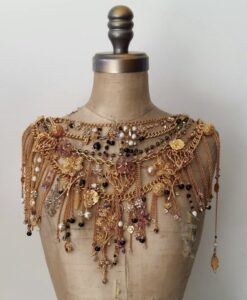
Charm necklace – mix of crystal, semi-precious stones and glass beads
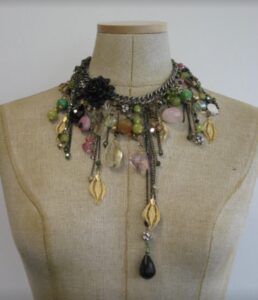
Facetted crystal and chain beaded caplet – photo by Tash Damjanovic
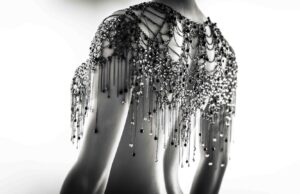
24kt gold plated chain and rhinestone cascading waterfall necklace
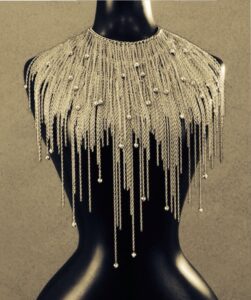
Multi-strand bib, collar necklace – mix of semi-precious stones, crystal and glass beads
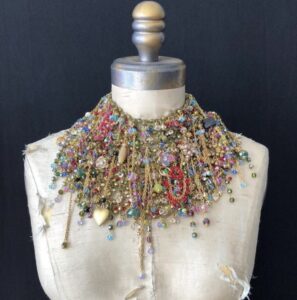
Transcript:
Colette Harmon has seen many trends come and go over the course of her career, but she has never let that influence her work. She has always found an audience for her one-of-a-kind jewelry, even when her hallmark maximalism is supposedly “out.” She joined the Jewelry Journey Podcast to talk about why she defines herself as an artist; how she nurtures her creative vision; and how her job as a leather accessories designer led to jewelry (and how that experience may come full circle in the near future). Read the episode transcript here.
Sharon: Hello, everyone. Welcome to the Jewelry Journey Podcast. This is the first part of a two-part episode. Please make sure you subscribe so you can hear part two as soon as it’s released later this week.
Today, my guest is Colette Harmon, who is speaking to us from Canada. Toronto to be more specific. I have to say I’ve never met her, and I’ve never seen her jewelry in person, but it’s my kind of jewelry. It’s over-the-top kind of jewelry. You may have seen it on a celebrity on the stage or screen, but if you’ve seen it, you’d remember it. I couldn’t find a lot of information about Colette, so I’m going to let her tell you her story. Colette, welcome to the program.
Colette: Thank you so much, Sharon. It’s a pleasure to be here.
Sharon: I’m so glad to have you. It took us a while to connect, to actually make this happen. Are you a designer? How do you refer to yourself? A Canadian designer?
Colette: That’s a good question. I don’t think of myself as Canadian, but I am a Canadian designer. I think of myself more as an artist as opposed to a designer. To me, a designer is someone who—can I start again?
Sharon: Yes.
Colette: Let me start again. To me, a designer is someone who creates things that can be worn by the masses, who is able to distill things and make them very simple so that everyone can wear them. Like you said, I’m more over the top. I don’t think about the masses. I create for myself. I create things that I, myself, would wear. I don’t really think about it, and I don’t really want the masses to wear my pieces. I want them to be unique. Maybe not one-of-a-kind, but limited editions. I don’t want to see my pieces everywhere on everybody. When you’re creating things that will be liked and appreciated by many, many people, it becomes distilled and watered down. To me, it loses its soul and its energy. Others might not think that, but that’s how I think of myself.
Sharon: I just wanted to ask you, you’re from Guyana. Am I saying that right? Guyana?
Colette: From Guyana, yes. I was born in a little place called Sisters Village, Guyana.
Sharon: When did you come over here? Were you young or a child?
Colette: I came at the age of five. I came with my parents, my mom and my dad. I have two brothers.
Sharon: So, you came with your family.
Colette: Yes.
Sharon: And when did you start designing jewelry or other things?
Colette: At a young age. I think I got my creativity from my mother. My mother was very creative. She was very musical. She sewed. She sang. She played piano. She was very creative. I think that’s where my creativity comes from. As a child, I was always drawing. I was very much in my head and my own little world as a child. I was always drawing and creating different things. I studied clothing design and thought I would be a fashion designer, a clothing designer.
How I ended up in jewelry was, when I graduated from school, there was a job advertised. I went to a school called Seneca College in Toronto. When I graduated, there was a job in the paper for an accessory designer; it was a belt designer. I had taken a course in college—I think it was just one semester—an accessory-making course. So, when I graduated, I saw the ad and thought, “I can make those.” So, I applied and got the job. I did that for about a year, year-and-a-half.
Then I left that job and started creating my own belts and handbags. One day I was doing a market show, and somebody asked me if I could make a pair of earrings to go with a belt they had purchased. I didn’t know anything about jewelry, so I just cut little squares and circles and covered them with leather. Looking back, they were horrible, but at the time I thought they were great. That’s how I got into jewelry. I never had any intentions of being a jewelry designer; I never thought of being a jewelry designer. That’s how I started. It just sort of happened. I have no idea. It wasn’t something I thought about, but I ended up becoming a jewelry designer.
Sharon: Do you have a lot of stylists as clients? They’re women, I presume. Are they stylists?
Colette: When I started doing jewelry, I started out wholesaling. I had an agent that would carry my pieces, and I sold to people like Holt Renfrew. I sold to Saks a little bit. I don’t know if you’re familiar with it, but there was a chain store here in Canada called Lipton’s. I sold to Lipton’s. I sold to better ladies’ boutiques. I got into doing custom pieces because it was very difficult wholesaling as a one-woman show. It was always very challenging getting paid on time, getting paid at all. When you’re small, I don’t know if it’s true for everyone, but with me, people like Saks, they would sometimes take six months to pay me if I got an order. It became very difficult waiting for money. So, I was doing wholesaling and custom work for a bit, and I segued into doing all custom.
Sharon: Did you leave manufacturing belts to have your own business?
Colette: I slowly moved away from the belts and got into jewelry. I can’t remember exactly how or when it happened, but one day, I ended up being a jewelry designer. I never thought about it. I didn’t plan it. Belts go in and out of style, so I guess there was a period where they weren’t selling as much. Belts weren’t in style, so I moved more towards jewelry. I guess I decided that I liked creating jewelry better than I did belts, and I just ended up in that field.
Sharon: I want to make sure that everybody knows that the jewelry you make is made with real stones and—I call them costume things—things that aren’t real, feathers and all kinds of things. Do you have an inventory?
Colette: Yes, I have quite a bit of stuff. I love to mix different things. I don’t follow any rules. I mix semiprecious with crystal and metal. Sometimes there’s sterling silver, and occasionally I’ll use a little bit of gold. A lot of it is plated. A lot of the metals are plated in either gold or silver. My strength is mixing, the way I combine different elements. I think that’s what my strength is. Some people only do semiprecious or only precious, but I like to mix and combine high and low things. I work with whatever I like. If I like something, I’ll use it. It has to speak to me. It may sound silly, but I think everything has an energy and they speak to you. They don’t speak to you in words or in language, but they have an energy and a feeling. I use what I like, what speaks to me.
Sharon: Do you create these pieces before there’s a need, before somebody comes to you and says, “I need a piece,” or do you create them when they say they need a piece?
Colette: I do a bit of both. Someone could come to me and say they’re going to an event. They might have a dress they need something to go with. A lot of times they just say they want a necklace and the colors and materials they would like to use, and they let me be free and do whatever. I prefer to work that way. I prefer to have creative freedom. A lot of times, someone will come and have something in mind, and I say, “That won’t work,” and they won’t listen. So, I do what they like, and you finish it and they say, “O.K., you were right.” I find a lot of people can’t visualize; they can’t see it. It usually turns out O.K. when I have creative freedom. I can’t create something that I don’t like. I have to like what I’m doing.
Sharon: What do you say if somebody says to you, “I want it this way,” and you think that’s not going to look good? What do you say or how do you deal with that?
Colette: I usually tell them. I’m usually very honest. Then I’ll do what they would like me to do. It usually turns out that it doesn’t look good, but that doesn’t happen very often. It usually works out pretty well. The people that come to me know what I do, so they know what to expect.
Sharon: Can you tell us a little about the people that come to you? Are they women? Are they stylists?
Colette: Mostly women. I do work with stylists. If someone’s doing a shoot, they might want me to create something, or they might pull from something I have. I don’t keep a lot of inventory. It’s mostly women that are going to an event or party. The past couple of years, there haven’t been very many parties, but they come to me if they’re going to a ball or a fundraiser or just for their everyday lives. They just want me to create something unique. People come to me because they want something different. I don’t pay attention to trends or what everyone is doing, so when they come to me, they know they’re getting something different.
Sharon: How do they hear about you?
Colette: Mostly through word of mouth. I’ve scaled back the marketing. It’s mostly through word of mouth.
Sharon: Do they see someone else and say, “Where did you get that?” and then they find you? How do they find you?
Colette: That happens. They might see someone else wearing one of my pieces. They might see something in a magazine. When I do editorials, people will call me. I’m in Toronto. I’ve had people call me from Vancouver after seeing something they like that they would like me to create for them. As I said, most of the pieces are either one or a limited edition. There might be pieces I’ve done when I can’t recreate them exactly, but they might be in different colors. Maybe that color is for a particular client or whatever material is not available, so it’s similar, but not exactly the same.
Sharon: What surprised you most about having all these requests?
Colette: I guess the most surprising thing is that there are actually people that love what I do. I don’t know if surprising is the right word. I guess it’s pleasing to know there are actually people that love it. I was known for these charm necklaces I’ve been doing for years. I had a woman that has maybe 30 of them.
Sharon: That’s a lot.
Colette: I guess it’s surprising and pleasing knowing that there are people that really love and appreciate my work.
Sharon: Do you have other collectors besides this woman with 30 pieces?
Colette: I would say I have maybe five people who—I know you’re familiar with Carole Tanenbaum. She has quite a few of my pieces. Should I say their names?
Sharon: It’s up to you.
Colette: There’s a woman named Nella Rosmand who has quite a few of my pieces. I have a client that lives in Yellowknife. Her name is Lisa Tousar. She used to have a store in Yellowknife. I think she’s closed it, but she’s bought a number of pieces. I had a boutique for a while. She bought a lot of pieces. She loves my work. There are maybe five or six people that have quite a few pieces.
Sharon: Do they wear them more than once?
Colette: I guess so. I guess they wear them. A lot of what you see on Instagram, what you mostly see, a lot of those are—I put the really over-the-top, elaborate pieces there. But I do simple pieces as well. They’re not always as elaborate as that. I also do some more subdued pieces.
Sharon: Your Guyanian and Canadian background, what influence does that have?
Colette: It’s actually Guyanese. Guyanian means people probably think I’m from Ghana. Guyanese is the term. I came when I was five and I’ve been back twice. I don’t know if being Guyanese has—maybe it’s something that’s subconscious, but it’s not something I think about because I grew up here. I grew up within a multicultural city, so there are influences from many places, I think. I don’t know if Guyana specifically has an influence on my work, unless it’s subconscious. I’ve had people say that my pieces look very African. I’ve had women from Africa say that it reminds them of it. But I don’t think it’s something I think about or do intentionally; I just do.
I’m doing a project right now with George Brown College here in Toronto. One of the professors, Leah Barrett, approached me about studying my creative process. I chuckled to myself because I don’t really have a creative process. I could sit down and sketch something, but once I start to make it, it turns into something completely different because I get ideas as I go. As I said, the materials speak to you. I create as I go along. If I have something in my mind from the start, when I finish it, it’s something completely different. I don’t really have a creative process. It sounds silly, but I just play. That’s what I do. I play.
I have to be honest. There are pieces I’ve created over the years that I don’t like, but a lot of times, those are the pieces that sell first. It’s like, “Oh my gosh, I don’t think anyone will ever buy that.” That’s the piece that goes first. I’ve sold a lot of pieces off of my neck. That’s happened quite a bit over the years. I remember once being at a party at a hotel in Toronto. I was in the washroom, and a woman said, “I love your necklace,” and I said, “Thank you,” and she was like, “I want that necklace.” I didn’t want to sell it, but she insisted. She wrote me a check in the washroom and I sold it to her. I actually regret it because it was one of those pieces I could never make again, but I find that people always want what I’m wearing. I’ve regretted selling a couple of pieces over the years because I could never make them exactly the same again.
Sharon: That’s interesting. You’re your own best model in a sense.
Colette: Well, I make them for me, to be honest. If I wouldn’t wear it, I couldn’t make it. I think that’s one of the reasons why I started creating my own leather accessories. I felt very restricted when I was working for—it was a company called Princeton Leathers. I always felt like I was in a box, and I just found it very difficult creating. There were two lines, one that was a luxurious line and one that was more simple. They would give me two findings and say, “O.K., now come up with something.” I was doing a dozen of these, and I found it very restrictive. If I won’t wear it, I can’t make it.
Sharon: Where do you get your ideas, if it’s not from somebody who shows you something and says, “I want something done this way”? Where do you get ideas from?
Colette: I don’t actively look for ideas. It’s just things you see and it’s collected in your subconscious. A lot of times, when I go and buy materials, I buy what I love, just pieces that I like. Sometimes they might be sitting on my desk for weeks and I have no idea what I’m going to do with them. Then one day, you might walk by and an idea just pops up in your head. I don’t actively look.
That’s one of the things I don’t like about social media. You’re seeing all of these things. I try not to look at other people’s jewelry, but you see it and it does influence your work when you’re looking at so many different things. I try not to look at it too much because I always want to be true to myself when I create. I don’t like looking at other people’s work too much because I find that it does influence you, whether you know it or not.
Sharon: Where do you look? Do you walk in the stores? Do you go downtown?
Colette: You know what? I was actually speaking to a friend the other day—he has a manufacturing company in India—saying that we should go out and see, because I have no idea what’s in the stores. I don’t pay attention to what’s in or what’s not in. Even at George Brown, in speaking with the students I’m working with, they were telling me that minimalism is back in style. I have no clue. I really don’t. I don’t know what’s in or what’s not. I don’t pay attention to any of that. I never really liked rules. If you love something, then wear it. Who cares if it’s in or if somebody else likes it? It doesn’t matter. You’re the one that’s wearing it. It’s how you feel in it. What other people think has no bearing. I’ve never understood that. This is in style or that isn’t in—if you like something, if you love it, then wear it. Who cares? I’ve never paid attention to rules.
Sharon: What was the context of them saying that minimalism is back in style?
Colette: I can’t remember what we were speaking about, but they were saying that maximalism is out and minimalism is in. You know how fashion goes in waves. I think that’s like when I was doing the belts. I guess we were going into a period where belts weren’t in style anymore, so people weren’t really buying. Eventually I started doing more and more jewelry pieces. That’s the thing; if you like belts, then wear belts. I guess with the wave of fashion and the way the system works, then the buyers aren’t buying. But I never really paid attention to what’s in.
Sharon: You closed your store. Now do you work out of your home or your studio?
Colette: I have a home studio, yes. I work out of my home.
Sharon: Do you have to go out and sell?
Colette: No, but I’m planning on opening up a showroom where people can actually buy things. I’m thinking about coming full circle and doing a line of leather belts and accessories and a little bit of jewelry as well, but I’m thinking about creating some leather pieces.
Sharon: Is that for stylists or is that for anybody who wants to come and look?
Colette: For anybody who wants to come in.
Sharon: Do they give you an idea of what they’re looking for most of the time? Sometimes they do and sometimes they don’t, as you said. But do most people coming in say, “I want something big,” or “I want something more muted”? What do they say?
Colette: You mean if someone came in and they wanted me to create something for them?
Sharon: Yes.
Colette: Sometimes they might come with a picture from a magazine or something and say, “I really like this,” in terms of style or size or whatever. So, I would create something with that feeling or those colors. Sometimes they bring a swatch of fabric to match, or sometimes they have an actual garment they want me to create something to go with. They might see something on my Instagram or on another person, something they saw someone else wear. It works in many ways. But if I were to create belts and bags again, I would do a line of pieces and people would just buy from what’s already created.
Sharon: Because it’s easier?
Colette: Yeah, because it’s easier. It would be easier. With the belts and bags, they would just buy from a line that’s already created.
Sharon: I can see how that would be easier than picking out jewelry or creating something to go with a garment.
We will have photos posted on the website. Please head to TheJewelryJourney.com to check them out.

